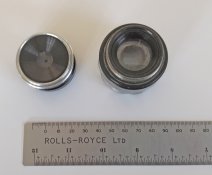tonyowen34
Member
I’m very very confused.
I’ve a Photax Paragon enlarger that handles (in metric) 35mm to 60x68 (sic) negatives AND an Astron 66 enlarger that handles 35mm to 60x60 negatives.
I have a Gnome f3.5 - 50mm lens (that came with the Astron) and a Wray SUPAR f4.5 - 4 ¼“lens (that was fitted in the Photax)
HOWEVER, whilst both lenses will fit securely into the Anstron enlarger, only the Wray will fit into the Photax enlarger. Further I’ve a M39mm (???) lens ring into which the Gnome lens will screw but the threaded end of the Wray drops through that lens ring.
The Astron lens thread socket appears to be straight, short and not stepped.
So what are the possible answers to my conundrum?
regards
Tony
I’ve a Photax Paragon enlarger that handles (in metric) 35mm to 60x68 (sic) negatives AND an Astron 66 enlarger that handles 35mm to 60x60 negatives.
I have a Gnome f3.5 - 50mm lens (that came with the Astron) and a Wray SUPAR f4.5 - 4 ¼“lens (that was fitted in the Photax)
HOWEVER, whilst both lenses will fit securely into the Anstron enlarger, only the Wray will fit into the Photax enlarger. Further I’ve a M39mm (???) lens ring into which the Gnome lens will screw but the threaded end of the Wray drops through that lens ring.
The Astron lens thread socket appears to be straight, short and not stepped.
So what are the possible answers to my conundrum?
regards
Tony













